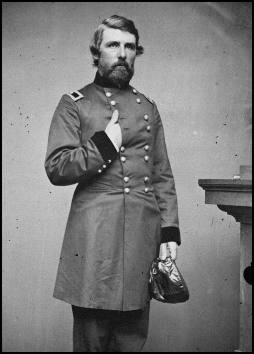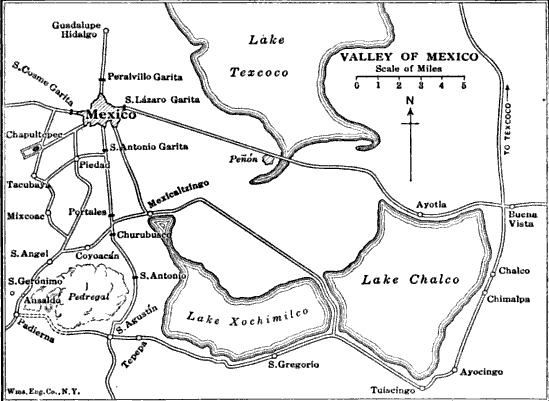|
Charles Smith Hamilton
Charles Smith Hamilton (November 16, 1822April 17, 1891) was a career United States Army officer who served with distinction during the Mexican‚ÄďAmerican War. He also served as a Union Army general during the early part of the American Civil War. After the war, he was appointed U.S. marshal for the Eastern District of Wisconsin by President Ulysses S. Grant, and served as president of the University of Wisconsin Board of Regents. Early life Charles Smith Hamilton was born in Westernville, New York, and was raised in western New York. He entered the United States Military Academy in 1839 and graduated in 1843, standing 26th out of 39 cadets; he was a classmate of Ulysses S. Grant, Christopher C. Augur, Joseph J. Reynolds, and several other men who would go on to become generals in the Army. First military service Upon his graduation, he was assigned to the 2nd U.S. Infantry Regiment as brevet second lieutenant. He was officially promoted to second lieutenant on November ... [...More Info...] [...Related Items...] OR: [Wikipedia] [Google] [Baidu] |
United States Marshal
The United States Marshals Service (USMS) is a federal law enforcement agency in the United States. The USMS is a bureau within the U.S. Department of Justice, operating under the direction of the Attorney General, but serves as the enforcement arm of the United States federal courts to ensure the effective operation of the judiciary and integrity of the Constitution. It is the oldest U.S. federal law enforcement agency, created by the Judiciary Act of 1789 during the presidency of George Washington as the "Office of the United States Marshal". The USMS as it stands today was established in 1969 to provide guidance and assistance to U.S. Marshals throughout the federal judicial districts. The Marshals Service is primarily responsible for the protection of judges and other judicial personnel, the administration of fugitive operations, the management of criminal assets, the operation of the United States Federal Witness Protection Program and the Justice Prisoner and Alien Tr ... [...More Info...] [...Related Items...] OR: [Wikipedia] [Google] [Baidu] |
3rd Wisconsin Infantry Regiment
The 3rd Wisconsin Infantry Regiment was an infantry regiment that served in the Union Army during the American Civil War. Service The 3rd Wisconsin assembled at Camp Hamilton, in Fond du Lac, Wisconsin, and mustered into Federal service on June 19, 1861. Its first commander was Col. Charles Smith Hamilton. The 3rd Wisconsin Infantry was a part of Gen. Nathaniel Banks' army during Jackson's Shenandoah Valley campaign of 1862. Later in the year, the 3rd Wisconsin took part in the fighting around the Cornfield during the Battle of Antietam. In 1863, after the Battle of Gettysburg, the 3rd was sent to New York, to help control the New York City draft riots. The regiment participated in the Grand Review of the Armies on May 24, 1865, and then mustered out at Louisville, Kentucky, on July 18, 1865. Total enlistments and casualties The 3rd Wisconsin Infantry initially mustered 979 men and later recruited an additional 940 men, for a total of 1919 men. The regiment lost 9 officers ... [...More Info...] [...Related Items...] OR: [Wikipedia] [Google] [Baidu] |
General Officer
A general officer is an officer of high rank in the armies, and in some nations' air forces, space forces, and marines or naval infantry. In some usages the term "general officer" refers to a rank above colonel."general, adj. and n.". OED Online. March 2021. Oxford University Press. https://www.oed.com/view/Entry/77489?rskey=dCKrg4&result=1 (accessed May 11, 2021) The term ''general'' is used in two ways: as the generic title for all grades of general officer and as a specific rank. It originates in the 16th century, as a shortening of ''captain general'', which rank was taken from Middle French ''capitaine général''. The adjective ''general'' had been affixed to officer designations since the late medieval period to indicate relative superiority or an extended jurisdiction. Today, the title of ''general'' is known in some countries as a four-star rank. However, different countries use different systems of stars or other insignia for senior ranks. It has a NATO rank sc ... [...More Info...] [...Related Items...] OR: [Wikipedia] [Google] [Baidu] |
Second Battle Of Corinth
The second Battle of Corinth (which, in the context of the American Civil War, is usually referred to as the Battle of Corinth, to differentiate it from the siege of Corinth earlier the same year) was fought October 3–4, 1862, in Corinth, Mississippi. For the second time in the Iuka-Corinth Campaign, Union Maj. Gen. William Rosecrans defeated a Confederate army, this time one under Maj. Gen. Earl Van Dorn. After the Battle of Iuka, Maj. Gen. Sterling Price marched his army to meet with Van Dorn's. The combined force, known as the Army of West Tennessee, was put under the command of the more senior Van Dorn. The army moved in the direction of Corinth, a critical rail junction in northern Mississippi, hoping to disrupt Union lines of communications and then sweep into Middle Tennessee. The fighting began on October 3 as the Confederates pushed the U.S. Army from the rifle pits originally constructed by the Confederates for the siege of Corinth. The Confederates exploited a gap ... [...More Info...] [...Related Items...] OR: [Wikipedia] [Google] [Baidu] |
Battle Of Iuka
A battle is an occurrence of combat in warfare between opposing military units of any number or size. A war usually consists of multiple battles. In general, a battle is a military engagement that is well defined in duration, area, and force commitment. An engagement with only limited commitment between the forces and without decisive results is sometimes called a skirmish. The word "battle" can also be used infrequently to refer to an entire operational campaign, although this usage greatly diverges from its conventional or customary meaning. Generally, the word "battle" is used for such campaigns if referring to a protracted combat encounter in which either one or both of the combatants had the same methods, resources, and strategic objectives throughout the encounter. Some prominent examples of this would be the Battle of the Atlantic, Battle of Britain, and Battle of Stalingrad, all in World War II. Wars and military campaigns are guided by military strategy, whereas bat ... [...More Info...] [...Related Items...] OR: [Wikipedia] [Google] [Baidu] |
Battle Of Yorktown (1862)
The Battle of Yorktown or Siege of Yorktown was fought from April 5 to May 4, 1862, as part of the Peninsula Campaign of the American Civil War. Marching from Fort Monroe, Union Maj. Gen. George B. McClellan's Army of the Potomac encountered Maj. Gen. John B. Magruder's small Confederate force at Yorktown behind the Warwick Line. McClellan suspended his march up the Peninsula toward Richmond and settled in for siege operations. On April 5, the IV Corps of Brig. Gen. Erasmus D. Keyes made initial contact with Confederate defensive works at Lee's Mill, an area McClellan expected to move through without resistance. Magruder's ostentatious movement of troops back and forth convinced the Union that his works were strongly held. As the two armies fought an artillery duel, reconnaissance indicated to Keyes the strength and breadth of the Confederate fortifications, and he advised McClellan against assaulting them. McClellan ordered the construction of siege fortifications and brough ... [...More Info...] [...Related Items...] OR: [Wikipedia] [Google] [Baidu] |
American Civil War
The American Civil War (April 12, 1861 ‚Äď May 26, 1865; also known by other names) was a civil war in the United States. It was fought between the Union ("the North") and the Confederacy ("the South"), the latter formed by states that had seceded. The central cause of the war was the dispute over whether slavery would be permitted to expand into the western territories, leading to more slave states, or be prevented from doing so, which was widely believed would place slavery on a course of ultimate extinction. Decades of political controversy over slavery were brought to a head by the victory in the 1860 U.S. presidential election of Abraham Lincoln, who opposed slavery's expansion into the west. An initial seven southern slave states responded to Lincoln's victory by seceding from the United States and, in 1861, forming the Confederacy. The Confederacy seized U.S. forts and other federal assets within their borders. Led by Confederate President Jefferson Davis, ... [...More Info...] [...Related Items...] OR: [Wikipedia] [Google] [Baidu] |
Comanche Wars
The Comanche Wars were a series of armed conflicts fought between Comanche peoples and Spanish, Mexican, and American militaries and civilians in the United States and Mexico from as early as 1706 until at least the mid-1870s. The Comanche were the Native American inhabitants of a large area known as Comancheria, which stretched across much of the southern Great Plains from Colorado and Kansas in the north through Oklahoma, Texas, and eastern New Mexico and into the Mexican state of Chihuahua in the south. For more than 150 years, the Comanche were the dominant native tribe in the region, known as ‚Äúthe Lords of the Southern Plains‚ÄĚ, though they also shared parts of Comancheria with the Wichita, Kiowa, and Kiowa Apache and, after 1840, the southern Cheyenne and Arapaho. The value of the Comanche traditional homeland was recognized by European-American colonists seeking to settle the American frontier and quickly brought the two sides into conflict. The Comanche Wars began in ... [...More Info...] [...Related Items...] OR: [Wikipedia] [Google] [Baidu] |
Battle Of Molino Del Rey
The Battle of Molino del Rey (8 September 1847) was one of the bloodiest engagements of the Mexican‚ÄďAmerican War as part of the Battle for Mexico City. It was fought in September 1847 between Mexican forces under General Antonio Le√≥n against an American force under Major General Winfield Scott at El Molino del Rey on the fringes of Mexico City. The Americans made little progress in this battle, but the Mexican forces were unable to hold them back long enough to prevent the capture of Mexico City one week later. Background The Americans were camped south of Mexico City, Scott and Worth's division at Tacubaya, Gideon Johnson Pillow's division at Mixcoac, David E. Twiggs division at San √Āngel, and John A. Quitman's division at San Agust√≠n. On 6 September 1847, Scott ended the armistice following the Battle of Churubusco as negotiations broke down, as it became clear that Antonio L√≥pez de Santa Anna was preparing to resume fighting.Bauer, K.J., 1974, ''The Mexican War, 18 ... [...More Info...] [...Related Items...] OR: [Wikipedia] [Google] [Baidu] |
Battle Of Churubusco
The Battle of Churubusco took place on August 20, 1847, while Santa Anna's army was in retreat from the Battle of Contreras or Battle of Padierna during the Mexican‚ÄďAmerican War. It was the battle where the San Patricio Battalion, made up largely of US deserters, made their last stand against U.S. forces. The U.S. Army was victorious, outnumbering more than two-to-one the defending Mexican troops. After the battle, the U.S. Army was only 5 miles (8 km) away from Mexico City. 50 Saint Patrick's Battalion members were officially executed by the U.S. Army, all but two by hanging. Collectively, this was the largest mass execution in United States history. Background Following their defeats at Contreras, Antonio L√≥pez de Santa Anna ordered Major General Nicol√°s Bravo Rueda with the Army of the Center, to retreat from San Antonio to Churubusco.Bauer, K.J., 1974, ''The Mexican War, 1846-1848'', New York:Macmillan, Santa Anna also ordered Major General Manuel Rinc√≥n to ... [...More Info...] [...Related Items...] OR: [Wikipedia] [Google] [Baidu] |
Battle Of Contreras
The Battle of Contreras, also known as the Battle of Padierna, took place on 19‚Äď20 August 1847, in one of the final encounters of the Mexican‚ÄďAmerican War, as invading U.S. forces under Winfield Scott approached the Mexican capital. American forces surprised and then routed the Mexican forces of General Gabriel Valencia, who had disobeyed General Antonio L√≥pez de Santa Anna's orders for his forces' placement. Although the battle was an overwhelming victory for U.S. forces, there are few depictions of it in contemporary popular prints. The armies re-engaged the next day in the Battle of Churubusco. Background General Gabriel Valencia's army of the north was part of the forces that fought at the Battle of Buena Vista in February 1847, in which Santa Anna retreated before giving a crushing blow to the forces of Zachary Taylor. The Mexican forces were then divided in two, with one sent to Cerro Gordo and the other to San Luis Potos√≠. General Valencia was given the command of ... [...More Info...] [...Related Items...] OR: [Wikipedia] [Google] [Baidu] |
Battle Of Cerro Gordo
The Battle of Cerro Gordo, or Battle of Sierra Gordo, was an engagement in the Mexican‚ÄďAmerican War on April 18, 1847. The battle saw Winfield Scott's United States troops outflank Antonio L√≥pez de Santa Anna's larger Mexican army, driving it from a strong defensive position. Background After United States forces captured the port of Veracruz on March 29, 1847, General Winfield Scott advanced towards Mexico City on April 2 by crossing the Rio Antigua.Bauer, K.J., 1974, ''The Mexican War, 1846‚Äď1848'', New York: Macmillan, General Antonio L√≥pez de Santa Anna, commanding Mexican forces in the area, had prepared fortifications at Cerro Gordo, near Xalapa, with more than 8,700 soldiers in a fortified defile, dominated by El Telegrafo. These included several batteries under the command of brigadier generals Luis Pinzon, Jose Maria Jararo, and Romulo Diaz de la Vega. Scott's leading division, commanded by David E. Twiggs, reached the Cerro Gordo Pass on April 12. Battle ... [...More Info...] [...Related Items...] OR: [Wikipedia] [Google] [Baidu] |









